Polycyclic aromatic hydrocarbons (PAHs) are potentially carcinogenic species present in the environment. In ambient air, the most toxic PAHs tend to be bound to airborne particulate matter, such as that generated from combustion processes. One major source of such particulates is the exhaust emissions of vehicle engines (particularly older diesel engines). In view of the continued need to reduce vehicle emissions and the toxicity of PAHs in the environment, it is important to be able to monitor the PAHs present in particulate matter from diesel exhaust.
In this Application Note, we build upon previous work1 to demonstrate how established methods for the sampling and pre-concentration of PAHs using thermal desorption (TD)2 can be enhanced by use of ALMSCO’s time-of- flight mass spectrometer (BenchTOF-dx) in conjunction with an innovative compound identification software package (TargetView).
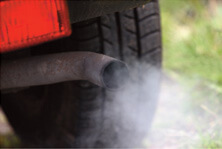
PAHs are often present at trace levels, and accurate identification and measurement in complex samples such as diesel particulate matter can prove challenging. However, the BenchTOF-dx time-of-flight mass spectrometer is ideally suited for the analysis of such samples, the following three features being of particular importance:
- Sensitivity: Highly efficient direct extraction (dx) technology allows BenchTOF-dx to acquire full-range spectra with SIM-like sensitivity, allowing it to reliably detect trace-level analytes.
- Spectral quality: The ‘reference- quality’ spectra produced by BenchTOF-dx are a close match for those in commercial libraries such as NIST or Wiley. This enables quick and confident matching of both target and unknown compounds.
- Speed: BenchTOF-dx acquires 10,000 full spectra every second, providing information-rich data sets that complement the latest data-mining software.
Background to TargetView
The advantages of BenchTOF-dx are enhanced by TargetView, a sophisticated post-run data processing package that allows accurate and automated identification of trace compounds in complex GC/MS profiles. TargetView uses sophisticated algorithms to eliminate background interference and deconvolve co-eluting components into individual analyte peaks. The mass spectra produced for each deconvolved component can then be rapidly matched against library spectra using advanced chemometric techniques, which allow both target and ‘unknown’ compounds to be identified confidently, even at trace levels. Total ion chromatogram (TIC) profiles can either be searched against a target library (a ‘target search’), or screened against the full NIST library (an ‘all-component search’). TargetView is easy to learn, simple to operate, and compatible with common GC/MS file types from major vendors.Experimental
Following ignition of the diesel engine, a stream of exhaust gas was sampled for one minute onto a quartz filter. A portion of this quartz filter (4 cm long × 4 mm wide) was placed in an empty glass TD tube and analysed using the following conditions: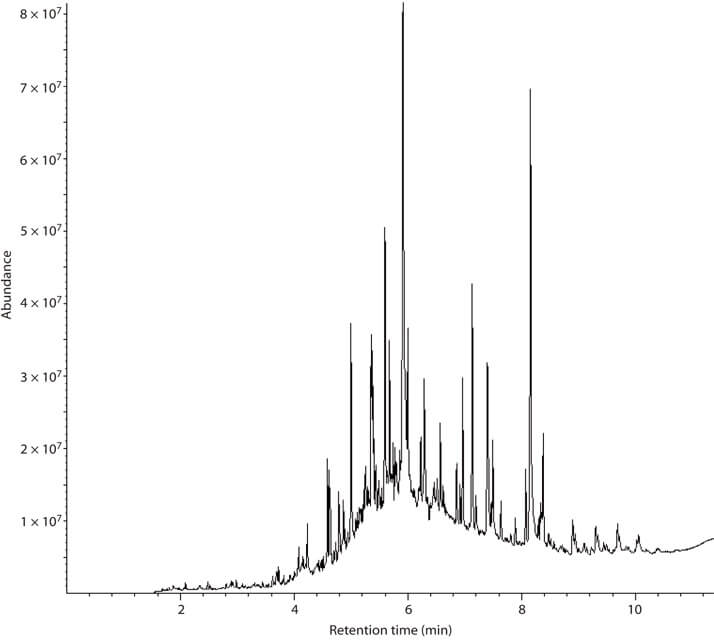
TD: Instrument: UNITYTM 2 (Markes International) Cold trap: U-T1HBL-2S (high-boilers trap) Pre-purge time: 1.0 min Desorption: 300°C, 15.0 min (20 mL/min to trap, 40 mL/min to split) Pre-trap fire purge: 1.0 min Trap low temp: 30°C Heating rate: Maximum (~100°C/s) Trap high temp.: 320°C Trap high time: 5.0 min Secondary split flow: 200 mL/min Flow path temp: 210°C GC: Column: BTX-5: 15 m × 0.25 mm × 0.1 μm Carrier gas: He, constant flow 1.5 mL/min Oven: 50°C (0.5 min), 30°C/min to 370°C (5.0 min) MS: Instrument: BenchTOF-dx (ALMSCO International) Transfer line: 300°C Ion source: 300°C Mass range: 40–400 amu Data rate: 2 Hz with 5000 spectra per data-point
Results and discussion
Figure 1 shows the total ion chromatogram (TIC) obtained for the diesel particulate sample. An overall split ratio of approximately 400:1 was used to prevent potential contamination of the analytical systems with high-abundance components. The drawback of using a high split is that already low levels of PAHs present in the sample are reduced even further. However, the inherent sensitivity of BenchTOF-dx combined with the post-run processing power of TargetView still allowed confident identification of multiple target PAHs in the sample. Matching against a PAH target library PAHs are often structural isomers, and therefore have very similar ion patterns in their mass spectra. To obtain accurate matches for PAHs, it is therefore often necessary to know their elution order (retention index) or their specific retention times, which in this case were obtained by analysing a standard PAHsolution (spiked onto a sorbent tube and analysed under the same TD/GC conditions). TargetView contains a function that allows matches to be penalised if they fall outside a pre-set ‘window’ of expected retention times. In this way, accurate matches of compounds with similar spectra but differing chromatographic retentivity can be obtained. Initially, the chromatogram was searched against a library of the 16 PAHs in the US EPA 610 list3. A spectral match factor limit of 0.70 was imposed on the search, and expected retention times for each compound were added to the library with an accompanying narrow retention time window. Following interrogation of the spectra obtained, six PAHs were confidently identified (Table 1).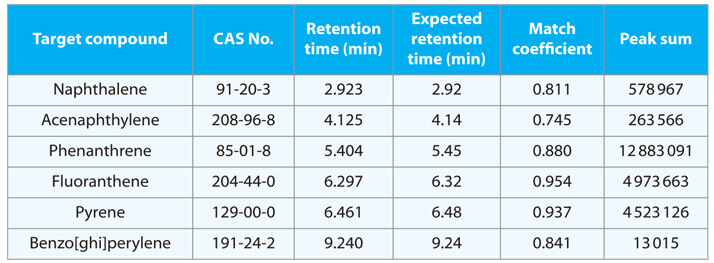
Accurate identification of PAHs with near-identical spectra A good example of how TargetView can be used to accurately identify compounds with almost identical spectra is the determination of fluoranthene and pyrene. The deconvolved peaks for each compound (shown in red within the TIC) are displayed in Figure 2 alongside the respective spectra from the NIST library. Match factors of 924 and 946 for fluoranthene and pyrene respectively demonstrate both the inherent quality of the spectra produced by BenchTOF-dx and the excellent performance of the TargetView deconvolution algorithm. Knowledge of their retention times (6.32 min for fluoranthene and 6.48 min for pyrene) provides additional confirmation of identification.
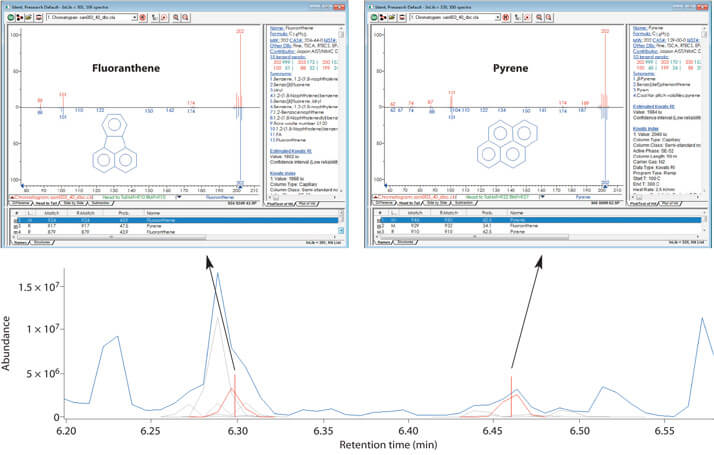
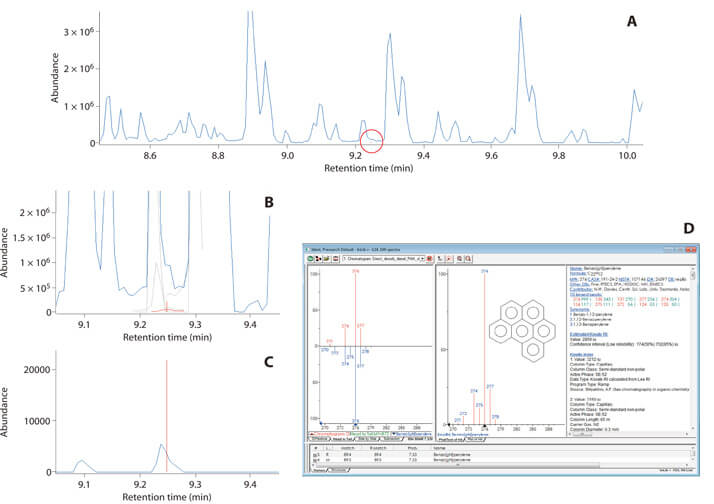
Detection of trace-level high-boiling PAHs The identification of benzo[ghi]perylene in the diesel exhaust is a good example of the power of TD–GC/TOF MS to analyse trace-level high-boiling components (Figure 3). The peak sums provided in the TargetView report (Table 1) indicate that it is present at levels 1000 times lower than the most abundant target component (phenanthrene) – but it nevertheless has a high match coefficient of 0.841. As before, the use of expected retention times in the TargetView library allows this isomer to be assigned with confidence. The traditional approach to detection of trace target analytes in complex chromatographic profiles involves the use of selected ion monitoring (SIM), but this then precludes the analysis of unknowns.
Conclusions
This quick study illustrates how the sensitivity, spectral quality and speed of BenchTOF-dx work together with TargetView’s sophisticated algorithms to enhance the detection of trace-level compounds in highly complex samples. When this approach is used in conjunction with the inherently sensitive technique of thermal desorption–GC, excellent analytical performance can be obtained even in the most challenging of scenarios, as demonstrated here for the detection of semi-volatile PAHs at trace levels in a complex diesel exhaust matrix.BenchTOF-dxTM and TargetViewTM are trademarks of ALMSCO International, UK (a division of Markes International Ltd).
UNITY 2TM and TD-100TM are trademarks of Markes International Ltd, UK.
Download the full Application Note here.
Applications were performed under the stated analytical conditions. Operation under different conditions, or with incompatible sample matrices, may impact the performance shown.
References
- See, for example: (a) E. Wauters, P. Van Caeter, G. Desmet, F. David, C. Devos and P. Sandra, Improved accuracy in the determination of polycyclic aromatic hydrocarbons in air using 24 h sampling on a mixed bed followed by thermal desorption capillary gas chromatography–mass spectrometry, Journal of Chromatography A, 2008, 1190: 286– 293; (b) M. Bates, P. Bruno, M. Caputi, M. Caselli, G. de Gennaro and M. Tutino, Analysis of polycyclic aromatic hydrocarbons (PAHs) in airborne particles by direct sample introduction thermal desorption GC/MS, Atmospheric Environment, 2008, 42: 6144–6151. Markes International Application Note TDTS 53: Quantitative recovery and method validation of high-boiling SVOCs using TD–GC/MS, http://www.markes.com/Downloads/ Application-notes.aspx. Appendix A to Part 136 (Methods for organic chemical analysis of municipal and industrial wastewater), Method 610 – Polynuclear aromatic hydrocarbons, US EPA, December 1996.




